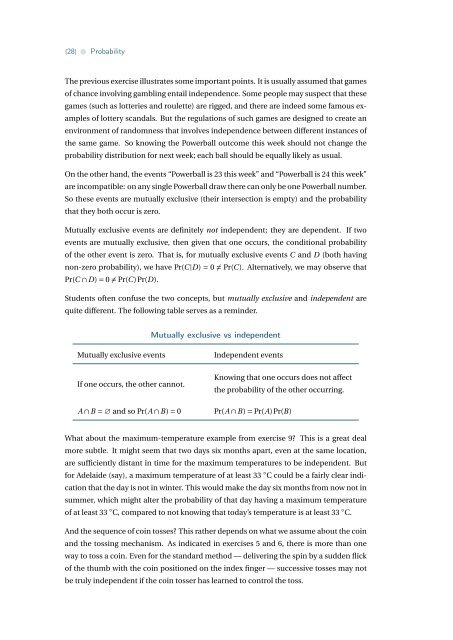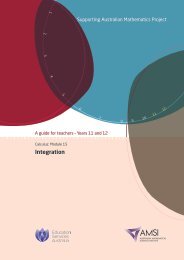Probability - the Australian Mathematical Sciences Institute
Probability - the Australian Mathematical Sciences Institute
Probability - the Australian Mathematical Sciences Institute
- No tags were found...
Create successful ePaper yourself
Turn your PDF publications into a flip-book with our unique Google optimized e-Paper software.
{28} • <strong>Probability</strong>The previous exercise illustrates some important points. It is usually assumed that gamesof chance involving gambling entail independence. Some people may suspect that <strong>the</strong>segames (such as lotteries and roulette) are rigged, and <strong>the</strong>re are indeed some famous examplesof lottery scandals. But <strong>the</strong> regulations of such games are designed to create anenvironment of randomness that involves independence between different instances of<strong>the</strong> same game. So knowing <strong>the</strong> Powerball outcome this week should not change <strong>the</strong>probability distribution for next week; each ball should be equally likely as usual.On <strong>the</strong> o<strong>the</strong>r hand, <strong>the</strong> events “Powerball is 23 this week” and “Powerball is 24 this week”are incompatible: on any single Powerball draw <strong>the</strong>re can only be one Powerball number.So <strong>the</strong>se events are mutually exclusive (<strong>the</strong>ir intersection is empty) and <strong>the</strong> probabilitythat <strong>the</strong>y both occur is zero.Mutually exclusive events are definitely not independent; <strong>the</strong>y are dependent. If twoevents are mutually exclusive, <strong>the</strong>n given that one occurs, <strong>the</strong> conditional probabilityof <strong>the</strong> o<strong>the</strong>r event is zero. That is, for mutually exclusive events C and D (both havingnon-zero probability), we have Pr(C|D) = 0 ≠ Pr(C ). Alternatively, we may observe thatPr(C ∩ D) = 0 ≠ Pr(C )Pr(D).Students often confuse <strong>the</strong> two concepts, but mutually exclusive and independent arequite different. The following table serves as a reminder.Mutually exclusive vs independentMutually exclusive eventsIndependent eventsIf one occurs, <strong>the</strong> o<strong>the</strong>r cannot.A ∩ B = ∅ and so Pr(A ∩ B) = 0Knowing that one occurs does not affect<strong>the</strong> probability of <strong>the</strong> o<strong>the</strong>r occurring.Pr(A ∩ B) = Pr(A)Pr(B)What about <strong>the</strong> maximum-temperature example from exercise 9? This is a great dealmore subtle. It might seem that two days six months apart, even at <strong>the</strong> same location,are sufficiently distant in time for <strong>the</strong> maximum temperatures to be independent. Butfor Adelaide (say), a maximum temperature of at least 33 ◦ C could be a fairly clear indicationthat <strong>the</strong> day is not in winter. This would make <strong>the</strong> day six months from now not insummer, which might alter <strong>the</strong> probability of that day having a maximum temperatureof at least 33 ◦ C, compared to not knowing that today’s temperature is at least 33 ◦ C.And <strong>the</strong> sequence of coin tosses? This ra<strong>the</strong>r depends on what we assume about <strong>the</strong> coinand <strong>the</strong> tossing mechanism. As indicated in exercises 5 and 6, <strong>the</strong>re is more than oneway to toss a coin. Even for <strong>the</strong> standard method — delivering <strong>the</strong> spin by a sudden flickof <strong>the</strong> thumb with <strong>the</strong> coin positioned on <strong>the</strong> index finger — successive tosses may notbe truly independent if <strong>the</strong> coin tosser has learned to control <strong>the</strong> toss.
















